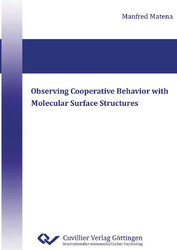| Fachbereiche | |
|---|---|
| Buchreihen (96) |
1378
|
| Nachhaltigkeit |
3
|
| Gesundheitswesen |
1
|
| Geisteswissenschaften |
2364
|
| Naturwissenschaften |
5406
|
| Mathematik | 229 |
| Informatik | 319 |
| Physik | 980 |
| Chemie | 1363 |
| Geowissenschaften | 131 |
| Humanmedizin | 243 |
| Zahn-, Mund- und Kieferheilkunde | 10 |
| Veterinärmedizin | 108 |
| Pharmazie | 147 |
| Biologie | 835 |
| Biochemie, Molekularbiologie, Gentechnologie | 121 |
| Biophysik | 25 |
| Ernährungs- und Haushaltswissenschaften | 45 |
| Land- und Agrarwissenschaften | 1004 |
| Forstwissenschaften | 201 |
| Gartenbauwissenschaft | 20 |
| Umweltforschung, Ökologie und Landespflege | 148 |
| Ingenieurwissenschaften |
1793
|
| Allgemein |
98
|
|
Leitlinien Unfallchirurgie
5. Auflage bestellen |
|
Erweiterte Suche
Observing Cooperative Behavior with Molecular Surface Structures
Manfred Matena (Autor)Vorschau
Inhaltsverzeichnis, Datei (100 KB)
Leseprobe, Datei (510 KB)
In the work at hand the interplay between molecules as well as molecules and substrate is studied in ultrahigh vacuum (UHV).
In Chapter 3 hydrogen-bond (H-bond) recognition, which is based on an H-bonding motif well-known in supramolecular chemistry, is investigated on Ag(111) for a three component system. Moreover, for one of the molecules a thermally induced phase transition from a porous network to a close-packed structure is found. Scanning tunneling microscopy (STM) and low energy electron diffraction (LEED) show that both surface structures exhibit long-range order and are commensurate with the Ag-substrate. In particular, this transition involves a conformational change of each molecule that is not observed in solution.
Chapter 4 deals with the study of intermolecular interactions of the perylene derivative 1,3,8,10-tetraazaperopyrene (TAPP) on Cu(111). Different surface structures are observed which exhibit different types of intermolecular interactions. Surface structures formed by TAPP molecules interacting via weak van-der-Waals forces are transformed into a long-range-ordered porous network upon annealing. For this network, which is commensurate to the substrate, the intermolecular interactions are based on the coordination of Cu-adatoms to the N-atoms of TAPP. Upon further annealing covalent C-C couplings between TAPP molecules result in the formation of chains. X-ray photoelectron spectroscopy (XPS) and computational studies using density functional theory (DFT) show that the N-atoms of the chains can coordinate to Cu-adatoms as well. Moreover, in a preliminary study the attempt was undertaken to create polymerized structures in two dimensions. However, the formation of ordered structures is a challenging task since self-correction that is inherent to weak reversible interactions is missing.
The molecule-surface interaction of a long-range-ordered porous network formed by the perylene derivative 4,9-diaminoperylene-quinone-3,10-diimine (DPDI) on Cu(111) is studied in Chapter 5. This network whose molecular building-blocks interact via H-bonds exhibits an extraordinary stability. In particular, the molecular adsorption height above the Cu surface determined by X-ray standing wave experiments (XSW) indicates that the molecular perylene core is not directly involved in a strong interaction with the surface. Thus, it is assumed that Cu-adatoms interact with the molecular N-atoms in order to explain the stability of the network. Moreover, scanning tunneling spectroscopy (STS) and angle-resolved photoemission spectroscopy (ARPES) reveal the formation of an electronic band which is induced by the periodic influence of the molecular network on the surface state of Cu(111).
| ISBN-13 (Printausgabe) | 3869551968 |
| ISBN-13 (Printausgabe) | 9783869551968 |
| ISBN-13 (E-Book) | 9783736931961 |
| Buchendformat | A5 |
| Sprache | Englisch |
| Seitenanzahl | 122 |
| Umschlagkaschierung | glänzend |
| Auflage | 1 Aufl. |
| Band | 0 |
| Erscheinungsort | Göttingen |
| Promotionsort | Universität Basel |
| Erscheinungsdatum | 28.12.2009 |
| Allgemeine Einordnung | Dissertation |
| Fachbereiche |
Physik
|








